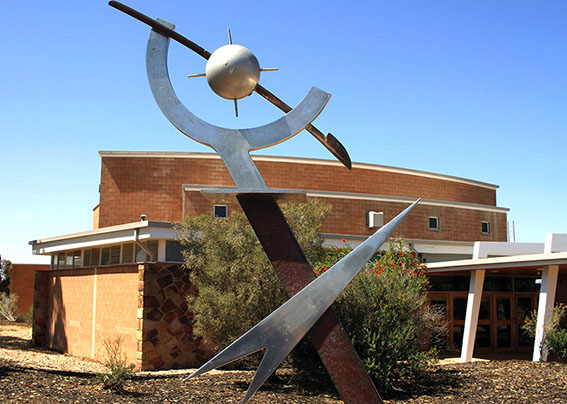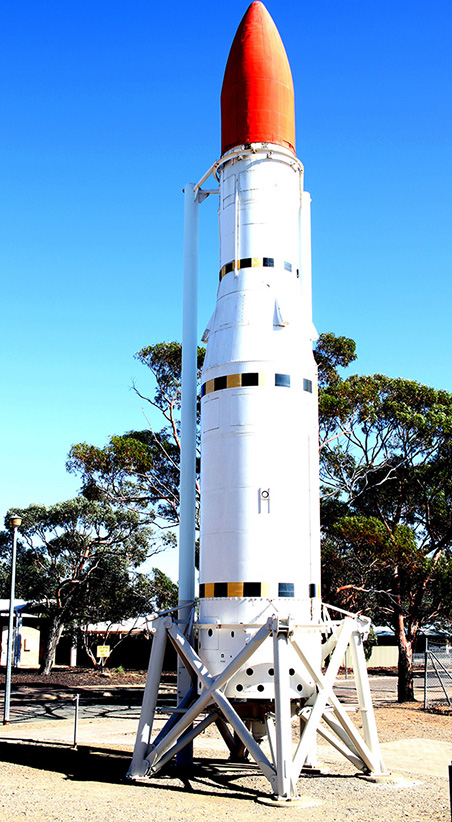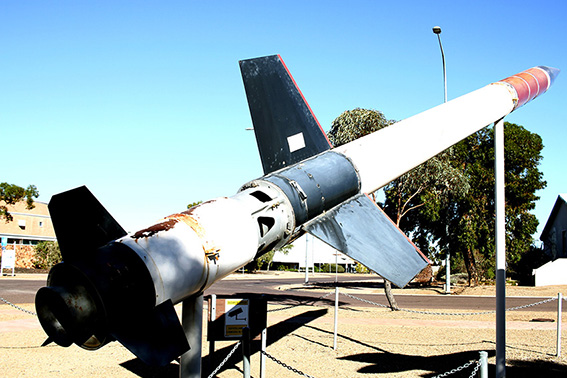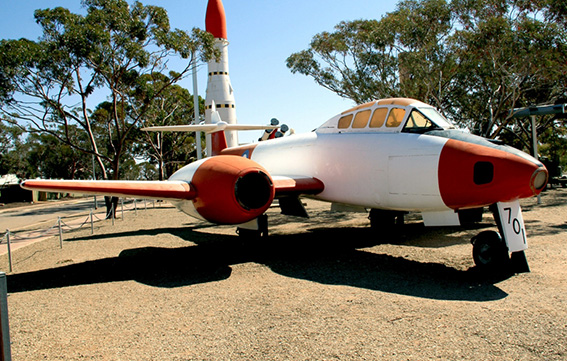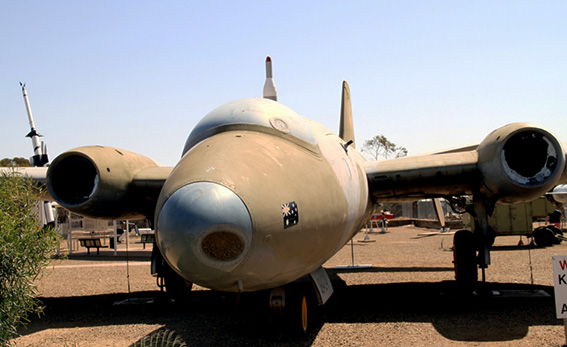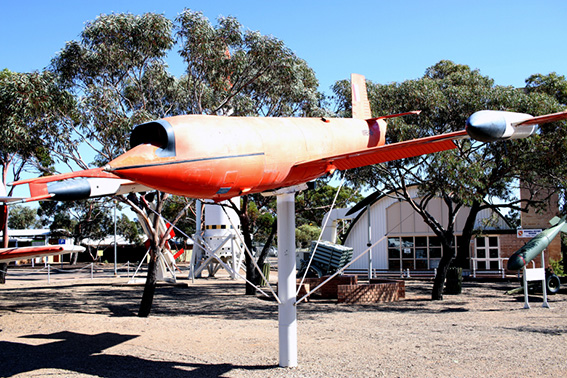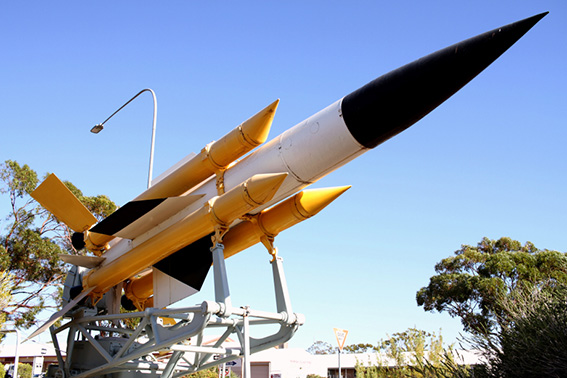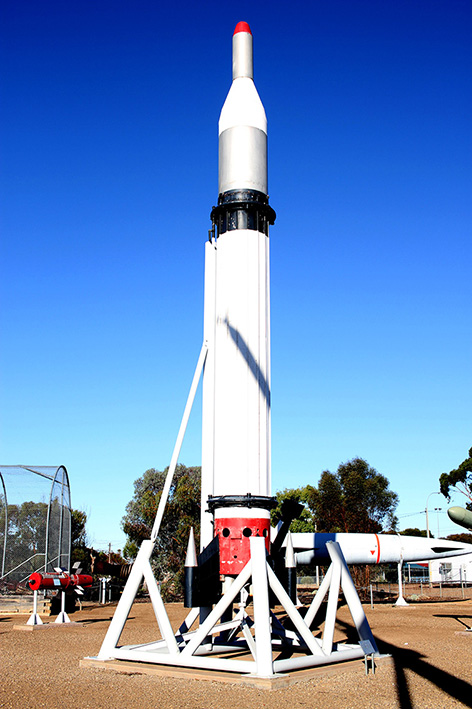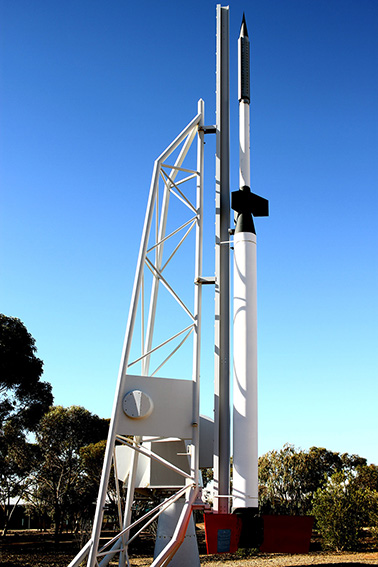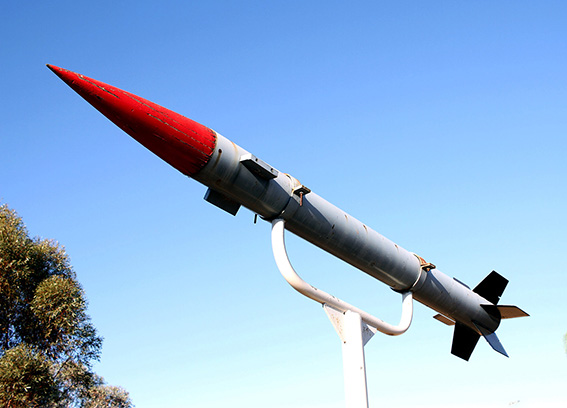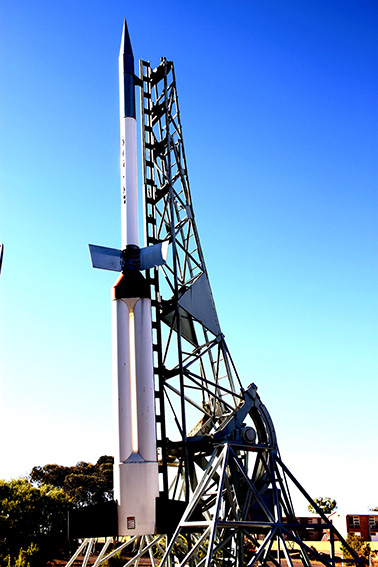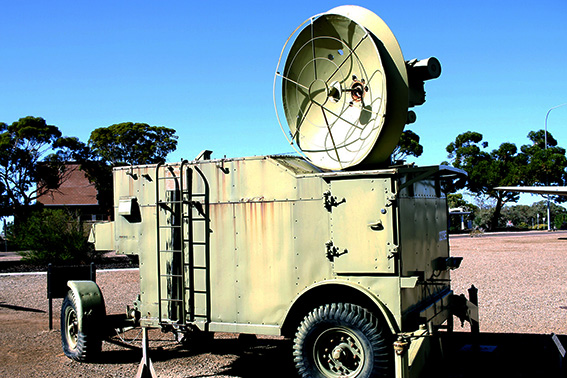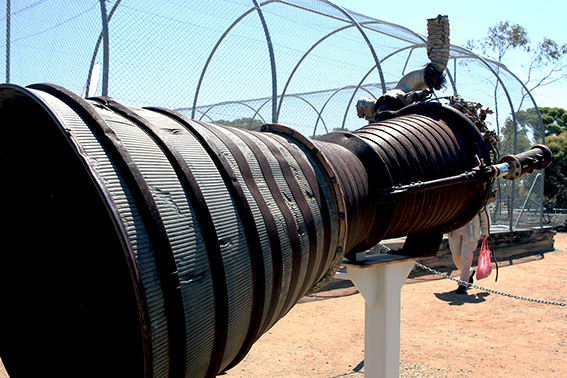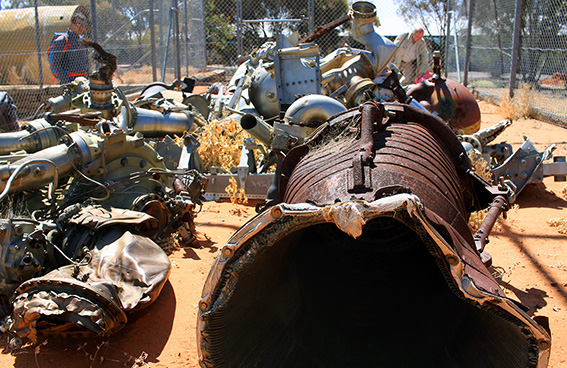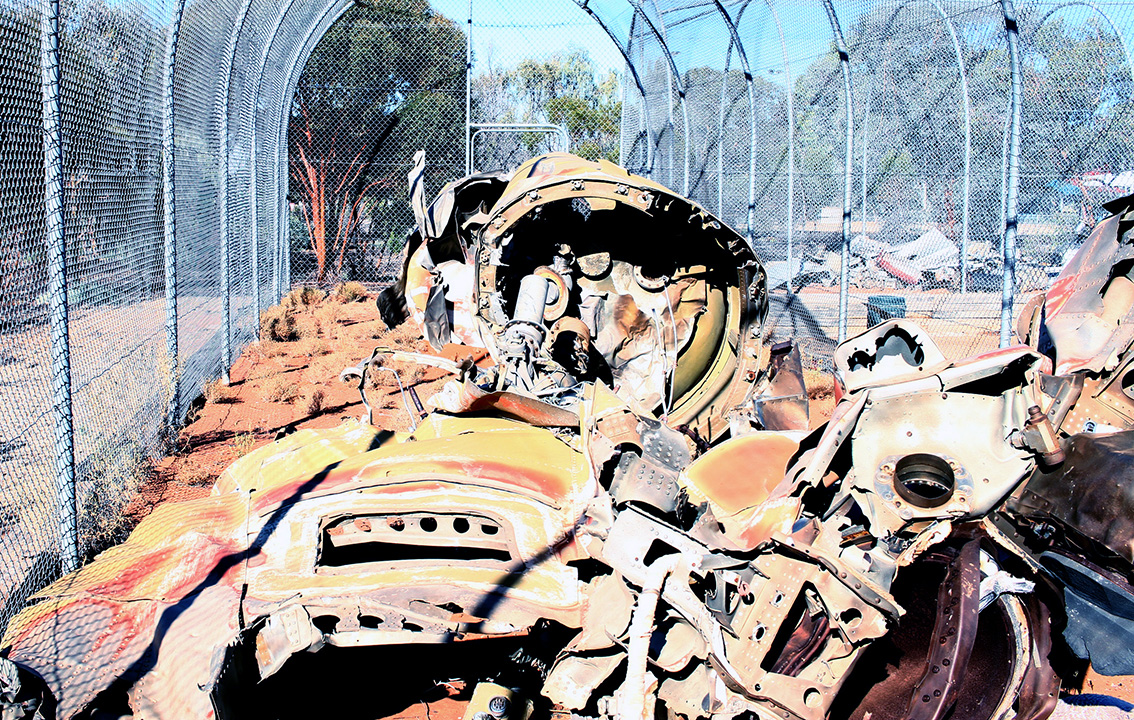The Woomera rocket park
OBELISK
The Obelisk, located right in the very centre of Woomera commemorates its founding in 1947 and is adjacent to the location of Len Beadell's original survey market. It depicts a stylised rocket, satellite, woomera (spear launcher) and a tracking dish.
Black Arrow
A three stage British rocket designed to carry a satellite into orbit. When fully loaded the Black Arrow stood 13m tall and weighed (at take-off) about 18 tonnes. Black Arrow used the proven technology and engineering of its predecessor Black Knight, but it needed to be a larger more powerful rocket. The 1st and 2nd stages were basically enlarged versions of the Black Knight. with more powerful engines burning the proven HTP (Hydrogen Test Peroxide) and kerosene mix. The third stage had a specially designed slow-burning and lightweight waxwing solid propellant motor. The satellite sat above the stage under a protective nose cone. Black Arrow had to carry the satellite up and away on a gradually curving ascent until, almost 10 minutes after lift-off and at 1.700km from Woomera; the upper stage would be flying parallel to-the Earth's surface at a height of 560km. At this point, with its speed approaching 8km per second, the nose cone halves would separate and the satellite would be released into permanent orbit. In 1969 and 1970 four BlackArrows were launched with varying Success to prove the system performance. October 1971 saw the fourth Black Arrow lift-off from Launch Area 5, taking the operational satellite Prospero into a perfect orbit. It was at this stage that the project was suddenly cancelled. Only Prospero, named after the magician from Shakespeare's The Tempest, remains in space as a tribute to the project. It circles the Earth every hundred minutes and unless tampered with, will continue to do so for a century to come.
Skylark
A British designed high altitude rocket first flown in 1957. Between 1957 and 1979 a total of 266 Skylarks were launched from tho Woomera range, employed as both high altitude sounding rockets and platforms to observe extra-terrestrial phenomena. Skylarks used one or two solid propellant stages to reach altitudes of 265km, with a payload of 300kgs. The payloads have included scientific equipment to study upper atmosphere conditions such as temperature, pressure in the ionosphere. radiation, micrometeorites, and distribution of ultraviolet radiation In 1987. a Skylark was launched to gather data from a supernova. marking the first flight in over nine years.
Meteor MK7
The Meteor entered service with the Royal Air Force in 1944 and was used against German V-1 rockets. This trainer Aircraft joined the Royal Australian Air Force (RAAF) in 1951 and saw service with 77 Sqn in Japan and the 78th Wing in Malta. Of the six MK7 trainers that were with the RAAF, the one on display here is believed to be the lost one remaining. The aircraft was powered by two Rolls Royce engines and flew at speeds of around 800km per hour. During the Jindivik trials, the now obsolete Meteor aircraft were converted into pilotless drones to present a larger target as required. The first unmanned Meteor flew al Evetts Field on 7th May 1957. During 477 sorties. which lasted until June 1974, 59 Meteors were destroyed in flight while a further 20 crashed through malfunctions.
Canberra Bomber
An English aircraft built by English Electric. It was commissioned in 1954 and contracted under licence to be built in America and Australia. The Canberra Bomber has two Rolls Royce Avon 101 jet engines with a maximum speed of 917km per hour. the coiling height was 14.5km and it had a range of .8km. The aircraft carried a crew of two and armament of six 1,000lb (approximately 453.5km each) bombs. In 1952 the first Canberra joined the eight Lincoln Bombers of the experimental flight at Woomera. Although acquired for the Blue Boar tests, the Canberra was in great demand for various services. In 1955 a second Canberra and a Vickers Valiant were added and slowly they replaced the Lincoln, as the Canberra had greater height and speed advantage. During research and development trials for the Blue Jay (1955 —1958), the missiles were fired from specially fitted RAAF Sabre and Canberra aircraft. The Canberra was also used in 1967 during the Ikara trials program for testing of payload development and missile guidance and tracking. Seventeen Canberra Bombers were converted to remote control by Short Brothers and Harland in Northam Ireland and flown to Australia. The Canberras were used as targets for ground to air missiles like Bloodhound. Thunderbird, and Seaslug. Even though they cost three times as much as a Jindivik when destroyed, It produced a radar image ten times as large and was closer in size and speed to an enemy bomber. The first target flight was flown in 1959 and the bomber was destroyed from the ground while at 50,000 feet. A further eleven were shot down before the service ended in 1965, while five more malfunctioned and crashed. The Canberra Bomber on display was rebuilt after being retired from use as a target aircraft.
JINDIVIK
This is an Australian designed and built pilotless target aircraft. Its name means the hunted one in the Aboriginal language. It was first manufactured in 1952 and the first successful flight was carried out at Woomera on 28th August that year at Evetts Field. Many Jindiviks completed over 100 flights. FtAAF pilot Sqn Ldr H.V. Sheam of ARDU shot down the first Jindivik destroyed over Range E. They were built to fly between 50.000 and 60.000 feet with 90 gallons of fuel. It has been through three model changes since the first prototype. The model on display is one of the later types, showing the wing extensions that gave the Jindivik extra lift and range.
THUNDERBIRD
The Thunderbird is a large ground to air anti-aircraft missile developed by English Electric of Luton, England. The missile went through many name changes during its development and testing. Depending on the version of modification being tested, it could have boon called Red Shoes, Thunderbird. Green Flax. Yellow Temple, Bloodhound or VR725. The missile's boost power was supplied by four solid fuel motors fitted around the body, while the actual rocket motor started with a liquid fuel but eventually went to a solid fuel too. The missile development and acceptance trials under the Red Shoe name started at Woomera In 1954, and the program was completed after many failures and mishaps in 1960, when the Thunderbird MK1 went into service with the British Army. The version used by the Royal Air Force (RAF) was called Bloodhound. From 1960 to 1965 further evaluation trials were run and the final version of the Bloodhound remained in service until the 1990s. The Thunderbird is on display outside the Woomera Heritage and Information Centre on Dewrang Avenue.
Black Knight
Designed in 1955 by the Royal Aircraft Establishment (ME) and Saunders-Roe. the Black Knight took four years to design and a team of 260 on two continents. The Black Knights were built on the Isle of Wight, and launches at Woomera wore carried oul between 1958 and 1965. Standing 10m tall, It was liquid fuelled and equipped with an elaborate guidance system. Black Knightwas originally designed as a cheap test vehicle to collect data on re-entry prior to work commencing on Blue Streak (a planned ballistic missile capable of carrying a nuclear warhead). While the early launches answered many questions raised It was initially felt that collecting data on the physics of high altitude were of secondary importance. When the Blue Streak program was abandoned, the Black Knight continued to be used for gathering data. often carrying experimental payloads. Many of the systems and parts were eventually used in the Black Arrow project. This is one of three remaining Black Knights in existence (the other two are on display in British muséums).
High Altitude Density
The High Altitude Density (HAD) is an Australian developed high altitude sounding rocket first launched in 1961. HAD was a two stage rocket that achieved an altitude of 120km. As the names suggests, the HAD was used to study air density, temperature. and wind most noticeably through a series of 'falling sphere' experiments. The sphere was a balloon made of aluminised polyester film that would Inflate on release and then slowly descend the atmosphere while being continuously monitored by ground radar. The first successful sphere was launched in March 1962 and eventually HADs were launched from Carnarvon. Western Australia. and Woomera simultaneously to measure the variations in the atmosphere over different parts of Australia. From 1962 HADs were also used by the University of Adelaide to launch payloads designed to study the chemical composition of the upper atmosphere in the southern hemisphere. By the late 1960s the HAD was replaced by the Cockatoo, which made its debut in 1970.
PETREL SUPERSONIC TARJET
A small rocket built by Bristol Aerojet In use around the world from 1967 to 1982. Modified Petrels were used as supersonic targets from 1973 to 1975. The Petrels were an unguided projectile and had to be aimed like a gun. They were fired from a 10m tube capable of reaching heights of 1.7km at Mach 2.3. Their range (once fired) was approximately 25km from the launch area.
LONG TOM
Long Tom was the first Australian sounding rocket developed In the late 1950s by the Weapons Research Establishment (WRE) As Britain worked on the Black Knight project, WRE produced the Long Tom as a cheap test vehicle to record trajectories and rocket behaviour al high altitudes. Long Tom stood 8.2m and consisted of two stages. Assembled at first using surplus British engines in a duster of three for the first stage, eventually at least 10 different variants were produced many using technology developed at WRE. The first launch was in October 1957 and gradually the reliability and performance improved. In 1959 the Long Tom carried a micrometeorite detector as one of the experiments conducted for the International Geophysical Year. By 1960 Long Tom was mothballed in favour of two new sounding rockets that had been developed- the High Altitude Density (HAD) and the High Altitude Temperature (HAT). The replica Long Tom can be found at the entrance to town.
No.3 Mk 7 Telemetry unit
"George" is a British AA No. 3 Mk 7 mobile radar unit used during trials on the Range in the early 1950s. It was designed during World War II for controlling anti-aircraft guns. Enemy aircraft were tracked by a narrow beam aerial insider the reflector dish, once locked onto a target the radar fed continuous data to the guns to pinpoint the target. On the Range it was used for tracking aircraft navigation. The data output was fed through to enable the aircraft's position to be plotted on a map of the Range. No. 3 Mk 7 were used from the very earliest trials on the Range in 1949 through until 1966 when it eventually gave way to newer technology
Rolls Royce RZ-2 Engine
This Rolls Royce RZ-2 engine was used in the first stage of the Europa F5 launched in 1966. The debris lay in the Simpson Desert undisturbed until first being discovered by C. Warren Bonython and Charles McCubbin 1973 as they walked across the desert. It wasn't until 1999 that the engine was recovered from the desert and returned to Woomera. where it remains on display.
Relics ELDO Europa Blue Streak
Britain's Blue Streak program to create an intercontinental ballistic missile, capable of carrying a nuclear warhead, was to have been the largest project tackled in Woomera in its era. A new launch site was developed on the edge of Lake Hart and the town of Talgarno sprang up in Western Australia at the very end of the projected Impact zone. In February 1960, the British Parliament announced the cancelling of the project, with American and Russian technology advancing at a faster pace to develop.nuclear deterrent technology. In 1961 it was announced that Britain and France would collaborate on creating a European satellite launcher creation of the European Launcher development Organisation (ELDO) with the addition of Italy, Belgium, West Germany, Netherlands and Australia. The existing Blue Streak rockets became the first stage of this exciting new program. The Europa consisted of three liquid fuelled stages. The Blue Streak, powered by two Rolls-Royce RZ-2 engines, was the first stage. The French designed Coralie, powered by four rocket engines. was the second stage and a German built ASTRIS third stage carried an italian build est satellite A total of 10 rockets were launched, 7 under the ELDO banner, with the earlier flights consisting of just a Blue Streak. Two were fired carrying a dummy second and third stage. The first of these was F4 which launched in May 1966. The flight was terminated 135 seconds after a malfunction was reported bringing the debris down in the Simpson Desert. It remained undisturbed until in 1993, a volunteer reconnaissance party located the site. A further land search was conducted in 1994 with one of the Rolls Royce RZ-2 engines being located the dummy satellite wich contained various electronics tracking transmetters and the flight recorders was dicovered buried under 1,2 m of sand . In 1997,after much planning, the rocket components were returned to Woomera with some additional help from the army LH (SAMR) APC Unit. The RZ-2 engine can be seen on display in the Woomera Heritage centre.The Europa rockets remain the largest rockets ever fired in Australia.
relics of the rocket Redstone
Woomera was the launch site of Australia's first satellite, WRESAT, on 29 November 1967. The satellite was Australian designed and weighed 45kg. It was launched using a Redstone rocket left over from a joint US/ UK trial and donated for the launch by the United States. During 1967 the Americans were using a series of three stage Redstone rockets for the Sparta project to investigate the phenomena produced when objects re-entered the atmosphere. The Redstono was a reliable rocket developed from the German V-2 rocket, and the satellite was built into the nosecone. The Redstone stood 28.1m tall and the first stage contained a single A-7 engine. The second stage was an Antares-2 and the third a BE-3. In 1990 a team of volunteers recovered the first stage of the Redstone in the Simpson Desert. Using coordinates provided by Dick Smith, the team travelled over 1.000km by track to find the debris. A plaque was erected at the site prior to their return journey. The display gives an indication of how the pieces were found in the desert.
Inscrivez-vous au blog
Soyez prévenu par email des prochaines mises à jour
Rejoignez les 19 autres membres

